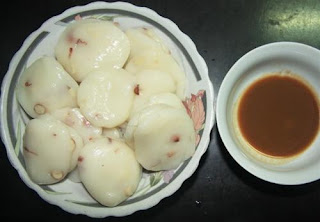The dried soya bean must be firstly roasted.
Tuong sauce has been a staple condiment for Vietnamese people for centuries. However, with so many other kinds of sauce produced nowadays, tuong is gradually losing its well established place on the dinner table.
Still, there are some special dishes such as braised fish or tofu that the likes of mayonnaise and chili sauce just can’t complement as well as good old fashioned soya sauce. Made out of soya beans and rice, it is also very rich in protein and good for health.
Ban Town, in Hung Yen Province, about 25km from Hanoi, is particularly famous for its good-quality tuong. In the nineteenth century, their special sauce was even chosen to offer to the King.
According to local woman Nguyen Thi Minh Quat, owner of one of the best known Vietnamese soya sauce brand names, Minh Quat Tuong, the secret of their good sauce lies in its careful preparation.
First of all, Quat says, you have to have the highest quality soya beans.
The next ingredient, which is of equal importance, is sticky rice.
The rice is soaked for a few hours and then steamed. The rice is then set on a broad basket, covered with longan leaves and left until it gets mouldy (this takes about three to four days). During this time, the soya beans are prepared.
The bean is roasted and then soaked in a jar of salty water for seven days in a cool storage area. After that, the rice mould is poured into the soya bean jar. The mixture is then crushed and dried in the sun for two to six months before it is ready to serve.
The sun is a very important factor in deciding the quality of the sauce. Therefore, people usually make a new jar from March to August when the sky is clearest. When the sauce is ready, it turns a dark brown colour and has a sweet smell and taste. If people strictly follow the process, a batch of tuong can be preserved from two to three years.
The sauce is stired sometimes.
For Vietnamese people, tuong is a traditional specialty which is often associated with poor but peaceful life in their homeland. In the past, every family would have a jar of the sauce to eat all year round to accompany almost every meal. This simple sauce has even become a symbol of Viet Nam, as expressed in the the popular poem:
Anh di anh nho que nha
Nho canh rau muong, nho ca dam tuong
Nho canh rau muong, nho ca dam tuong
Translated as:
Wherever I go, I will always feel nostalgic for my home country.
I miss the water morning-glory soup, and miss the egg-plants dipped in soya sauce.
This also explains why this traditional sauce can now be found in the US, Australia, France and more. In any country, if you can find Vietnamese people, you will be sure to find a bottle of tuong.






















